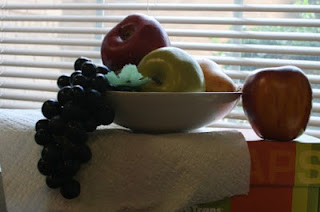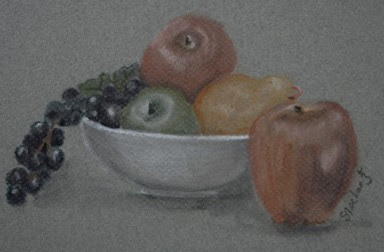Drawing what you see, not what you think you see
 |
| Sill life set up |
Sounds funny, doesn't it. Of course you are trying to draw what you see. But doing it can be tricky. I had a student, a man, doing a simple drawing of a still life. (drawing from life can be an real eye opener!) It was of a shallow bowl containing 3 apples. He worked on it for a while, then I stopped him to really look at the drawing and see what was developing.
Still life With Fruit
Now, this bowl was on a box, at eye level. But he drew it as if he were looking down on it. His minds knew it was a round bowl, even though from the angle he was looking at it, he could not see the roundness of the bowl. But he kept trying to draw it as it was, not as he actually saw it.
 |
| what was drawn |
The same thing often happens when we try to draw a chair. If the seat is near eye level, we will see a rather flat rectangle, but our mind will almost force us to draw that seat larger, big enough for our, well, backsides, to fit on it! So what happens is that we have a chair that appears to be falling apart!
Frustrating!
Learning to draw exactly what we are seeing, from the viewpoint we are looking at right now can be hard. But this is the key to learning to drawing. You must retraining your vision. Actually, your vision is fine, but you have to learn to trust it. To believe it.
After a certain age, when you have mastered holding and controlling your pencils, and other tools, what you need to do to learn to draw is to master perception. And to learn to see what is actually in front of you. And fight the inclination to draw anything other than what you actually see from the “now” point of view.
You need to fight the urge to jot down the short hand symbols you have relied on. Now there is nothing wrong with this symbolism. This symbolism is what allows us to learn to read. (One reason it is not necessary to try and teach young children to draw realistically before they are ready. Very young children are immersed in this symbolism, and it is necessary to where they are in the now).
Later in life, you do want to get beyond the symbolism. Lollipop people are not good enough. If people cannot make it beyond this, make the jump from the symbolic drawing of extreme youth to some level of realism; most will give up on art. At least, they will give up on drawing. It always surprises me how many painters and other artists really cannot draw, and do not like to draw.
You might think the ability to draw would be fundamental to any artist and art student, but sadly it is not. Many painters do not draw well, and never draw if they can help it. This is sad because they miss out on one of the greatest joys of art. And it is more than anything this inability to see well. To focus on what is really there and reproduce these “real” shapes.
The First Step
The first step in this drawing is finding the basic shapes in things. Getting down the true and real relationships between objects and even parts of objects and their placements. Yes, this involves perspective but don’t panic, we aren’t going there now!
Mostly it is about placing things where they belong and in the right sizes. It can be as simple as that. Getting things where they belong, and sized correctly in relationship to other objects you are including.
Many people will say, well what is wrong with his drawing, it is creative. It is only creative if that is what he wanted to do. But you see, he
thought he was drawing what was before him. This is what he wanted to do. When I point out to him what he had actually done, he was stunned. So no, it is not "creative".
 |
| Above the still life |
Look at what that still life set up would look like from above, the angle he was drawing. Here we do see the curve of the bowl. But we see very little of the side. Also we see the fruit from on top, not the side view
Now the still life set up as he was viewing it was from straight on. From eye level, the round bowl appears as a straight line, with the side of the bowl in view. And the fruit, from that angle is seen totally differently.
I want people to be able to really see what is in front of them. To be able to really see and record what they want. If you want to change the view, let it be because you have decided to, not because you cannot do anything else.
 |
| Still Life with Fruit |
 But several students are moving on already. Exploring all aspects of perspective as well as the mechanical objects we surround ourselves with.
But several students are moving on already. Exploring all aspects of perspective as well as the mechanical objects we surround ourselves with.















































